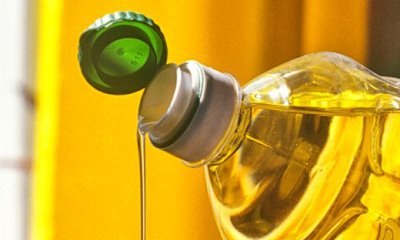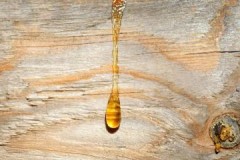Effective ways of how and how to remove wood and epoxy resin from hair
 A similar nuisance can happen both during construction work and on a walk in the forest. It is sometimes easier to rinse the resin off the hair than on skin or clothing.
A similar nuisance can happen both during construction work and on a walk in the forest. It is sometimes easier to rinse the resin off the hair than on skin or clothing.
Nevertheless, there are many simple ways to solve this problem, the effectiveness of which depends on the type of hair, the nature of the pollution and the speed of its removal.
How and how you can remove resin from hair, we will tell in the article.
Content
What's the first thing to do?
The primary task is to separate the soiled strand from the rest of the hair... A plastic bag, cling film or foil is suitable for this.
How to remove with improvised means?
The easiest and quickest way to fix the problem is to cut off the damaged strand. If the pollution covers too much of the hair and a haircut is not desirable, you can resort to a few simple, but very effective tricks.
Vegetable oil and other fat-containing foods
 This method is suitable for tree resins.... Thoroughly lubricate the contaminated area with oil and leave for 20-30 minutes until the resin is completely softened.
This method is suitable for tree resins.... Thoroughly lubricate the contaminated area with oil and leave for 20-30 minutes until the resin is completely softened.
It can be slightly warmed up for better performance. Then, using a comb with rare teeth, gently comb the strand, simultaneously pulling out the pieces of resin. Then rinse your hair with plenty of shampoo or soap.
How to remove with alcohol?
Perhaps the best remedy for removing such contaminants. In particular, because it is found in most natural and synthetic resins.
It is enough to soak a cotton pad or a piece of cloth in alcohol and rub gently into the resin... When the substance begins to separate from the hair, comb it out with a comb and rinse your hair with shampoo several times.
Petrol
Blot cotton wool or a piece of gauze with a few drops of gasoline. Apply to the stuck together area, then carefully comb out the softened resin and rinse your hair several times with detergents.
Cooling
As the temperature drops, the resin becomes less elastic... If the piece is small, it can be crumbled and removed from the hair with a comb.
If this is a root zone, the strand should be kept raised to avoid hypothermia of the scalp.
Heating
 Some hard resins soften already at 50-80 ° C... A similar temperature range is capable of producing the most common household hair dryer.
Some hard resins soften already at 50-80 ° C... A similar temperature range is capable of producing the most common household hair dryer.
To do this, set the maximum temperature regime and act directly on the contaminated area with a continuous air flow.
If the tarnished area is close to the scalp, then the skin must be covered with a tight bandage to prevent thermal burns.
How can you wipe off with special compounds?
In addition to household products, resin removal is possible using special reagentsspecializing in the development of varnishes and paints based on resins and their derivatives.
Gum turpentine
Unlike technical turpentine, it does not burn the skin and does not cause an allergic reaction. Can be purchased at the pharmacy as a balm. The average cost is 200 rubles. for 250 ml.
How to cleanse with white spirit?
The application technique is the same as with other organic solvents. However, the procedure time should be shortened, since prolonged inhalation of vapors negatively affects the central nervous system. Sold in any hardware store. The average cost is 100 rubles. for 0.5 liters.
Acetone
Widely used in everyday life and industry... Dissolves varnishes and paints based on cellulose nitrate. Partially destroys rubber in large quantities.
Released in hardware and building stores. Price - from 80 rubles. for 0.5 liters.
Features of cleansing different types of curls
When choosing a product, it is important to take into account the condition of the hair. The structure and density will determine not only the effectiveness, but also the safety of a particular method:
-
 For rare and thin vegetable oil or any fat-containing product is better for hair. It can be mayonnaise, petroleum jelly, fat baby cream.
For rare and thin vegetable oil or any fat-containing product is better for hair. It can be mayonnaise, petroleum jelly, fat baby cream.Apply liberally to the problem area and cover with cellophane or foil for 30-40 minutes. Then comb the strand, while removing soft resin lumps in parallel.
- For thick combined the hair method above may not be effective enough. In this case, use the ice cooling method. It will take a lot of time, but it will have minimal traumatic effect.
- For fat hair, you can use alcohol, acetone, nail polish remover, and other acceptable solvents. However, before using this method, it is worth trying a more gentle method.
For sparse as well as oily hair, you can use the hot blow method. For thick ones, it will be more troublesome, since it will take a long time to comb out the softened resin.
After using a hot hair dryer or solvents shampooing must be completed by applying balm and / or a moisturizing mask.
The nuances of removing various types of resins
Wood resin is much easier to remove than synthetic resin. It is softer in nature and contains substances such as alcohols, acids and oils. The use of compositions based on similar components (ethanol, turpentine, other solvents) allows you to effectively remove the resin ball without much effort.
Epoxy resins contain hardeners... This makes most of them resistant to weak acids and alkalis. Therefore, it is recommended to remove the resin from the hair for several hours until it is completely hardened.
What cannot be done?
If the resin gets on the hair, it is strictly not recommended to use aggressive solvents - removers, DMF and acids to remove it.They are designed for metal surfaces, and therefore instantly leave a burn on the skin and damage hair.
Advice
 If the resin cannot be wiped off for a long time, do not despair and cut off the strands. In some cases, hair cleansing occurs within half an hour, and sometimes up to several hours.
If the resin cannot be wiped off for a long time, do not despair and cut off the strands. In some cases, hair cleansing occurs within half an hour, and sometimes up to several hours.
Proven to be the best resin remover with pure ethyl alcohol... If it does not help effectively enough, it is necessary to dilute it with turpentine in a 1: 1 ratio.
Apply the resulting solution in a small amount on a cotton pad and rub into the tarred area until the clot softens.
For recipes and tips for removing tar from various surfaces, see this section.
Conclusion
The key to successful resin removal is to implement the necessary measures within the next few hours. Substances that are widespread in everyday life can act as auxiliary agents: oils, cream, alcohol.
If the contamination turns out to be difficult to remove, solvents such as acetone and turpentine will come to the rescue.... However, it is worth remembering that prolonged exposure to such substances on the skin and respiratory organs can lead to edema and intoxication.



